I don't think I really care to admit how long ago I purchased a manual flash for my olympus; but it's been years. You'll note, there are not many—maybe not any —images shot with flash on the site. That's because I never really figured out how to use the thing. Nevertheless, while tidying up sometime this...summer? I (re)discovered a bunch of assorted cords, left over from my old film (Canon T70) days. I put them in the desk drawer with my other photographic odds and ends, and there they sat, until Kristin Perkins asked me to photograph a bunch of her stuff, including a lot of pendants.
The pendants I can (more or less) shoot with photofloods, because I can usually rest the bottom of the pendant on the background, just enough to keep it from swaying:
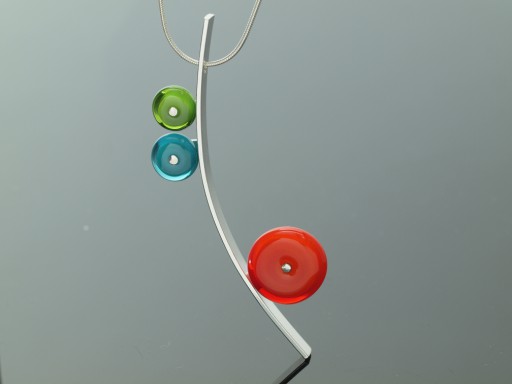
This gorgeous is pendant is from my latest batch of photography of her work. It's shot f8, with a brand new 500w photoflood, at about 1/10 sec—the lower range of the 1/5 to 1/8 I shot most of this batch of jewelry.
The biggest problem is that I get this ‘line’ 2/3 of the way along the image, where background meets the backdrop.[1] I solved this, finally, by reducing the DOF and shooting at a very slight angle (that is with the lens pointing slightly down, rather than straight back) and by ramping the plexi slightly up.
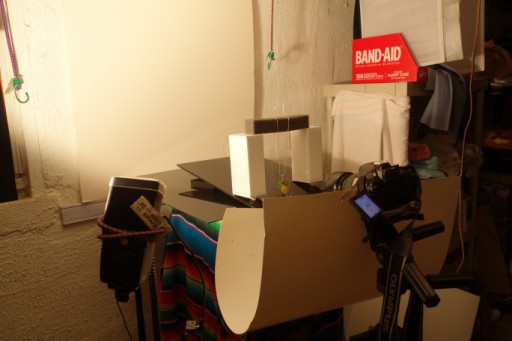
My oh-so-professional setup. [2] I find with the jewelry positioned between the two boxes I don't even have to hold up a diffusing panel, as I would if the jewelry was just lying flat on the plexi.
In the past I simply set up the white boxes as far the foam would permit, and they acted simultaneously to block specular highlights,[3] and bounce light through the glass, while permitting it come in from the back.
Setup:
- incline background (plexi) up towards back (with a piece of foam)
- spread white shipping boxes as far apart as possible.
- level boxes with white handi-tac (vertical orientation for necklaces)
- use pins in foam to position pendant so it just touches surface
- diffusing panel not necessary, boxes act to block direct (specular high) light
- incline camera slightly downward; f8 sufficient
- photofloods easier than flash, shot mostly at 1/6 – 1/8, with some 1/5, 1/10
- 10x magnification makes it easy to determine movement
- don't forget the usual dust, fingerprint, etc inspection/clean
So far, so good. But what about earrings, which are much harder to hang?
Because there are two of them, that means I have to futz around getting two items to just touch the background, not to mention be a good distance from each other. They slip off the monofilament; which, because it's so fine, means they often never stop swaying.
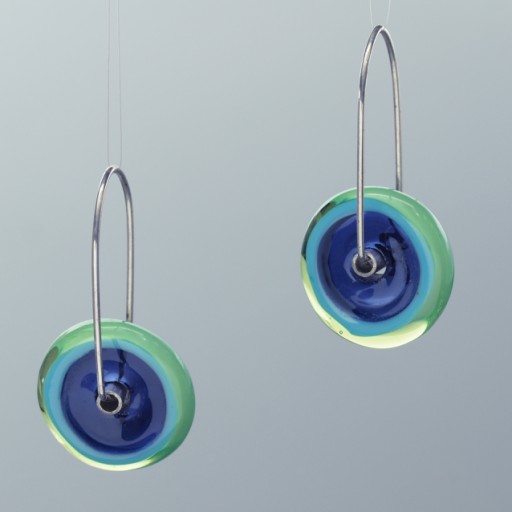
A pair of earrings made by Kristin Perkins, shot conventionally with photofloods.[4]
Which shows up as blur in photos taken at 1/8 sec. The only reason I managed this pair is because they had two days to settle down; but it's impractical to wait 48hrs between shots in a professional shoot.
The answer, obviously, is to shoot earrings with flash, which stops motion dead.
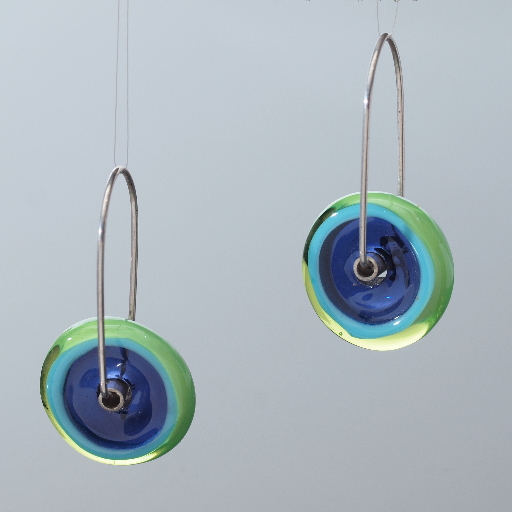
The same earrings, shot with flash. Yes, despite the diffuser on the flashhead, I need to get rid of the hot spots.
So I dug out the various pieces and parts, put them on backwards, eventually figured how to connect the camera to the flash, read the 4 page flash manual, and after a few false starts got the flash to fire, without also firing the camera's own flash.
Adjustments for flash:
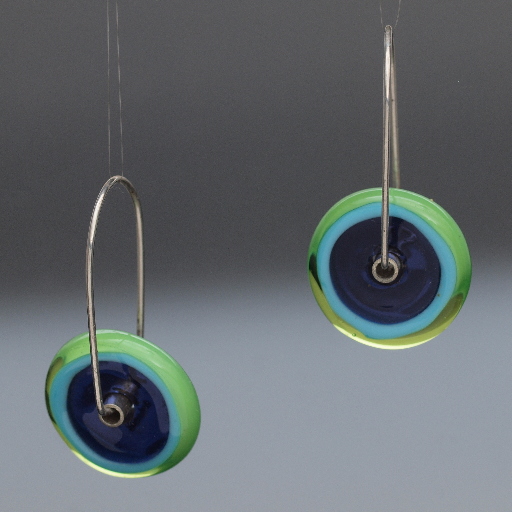
In this image, with the coveted dark to light gradation, I used the 6–8" wide piece of diffusing plastic positioned directly over the lens at a slightly greater than horizontal angle to ‘cut’ the light (as with a barn door). But my results were erratic, and I wasn't able to reliably reproduce the effect.
Both the earring images have had slight color balancing done on them, and my flash images read a little blue, which means I need to do some fine tuning. Nevertheless I finally successfully got the flash to work well enough to actually start playing with this technique.
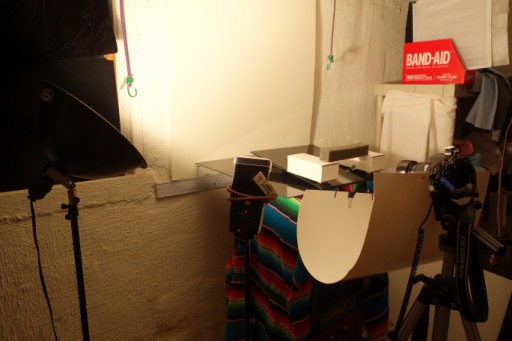
Very similar to setup above, except I rotated the boxes 90 deg along short axis, since I didn't need as much height for the earrings.
I also broke down and blacked out the windows. Yes, it's time & past to get some curtains for them so I can photograph during the day—though one downside of flash photography is that I have to keep turning on the photoflood on for modeling (i.e. to set up the shot, focus, etc.) and then off again so as not to mess up the white balance or create ghost images. However, the number of fstops between flash and daylight is so great I think it might not be a problem: there's not enough difference between daylight[5] and the photoflood, just as there isn't enough between the photoflood and the flash; but between dim daylight and flash?
This should be fun:)
[1]I shoot these pieces on flat black plexi, which doesn't curve up like the paper background I typically use for my own work.
[2]I didn't use the flash in this picture, but yes, it really is bungeed to the lightstand. Sigh.
[3]There is one tiny one, but I don't think it's a problem.
[4]These date pretty much back to the beginning of our business relationship, so they're not her current work.
[5]That is, the amount of light that leaks in through the windows...
Unless otherwise noted, text, image and objects depicted therein copyright 1996--present sylvus tarn.
Sylvus Tarn